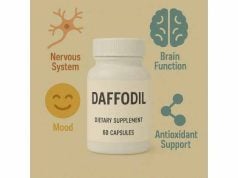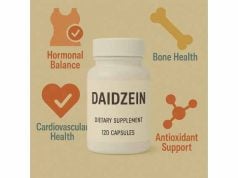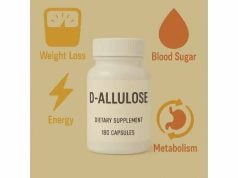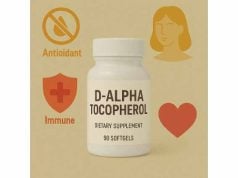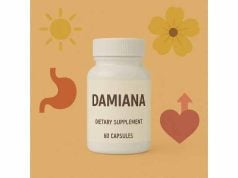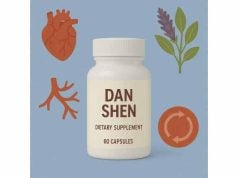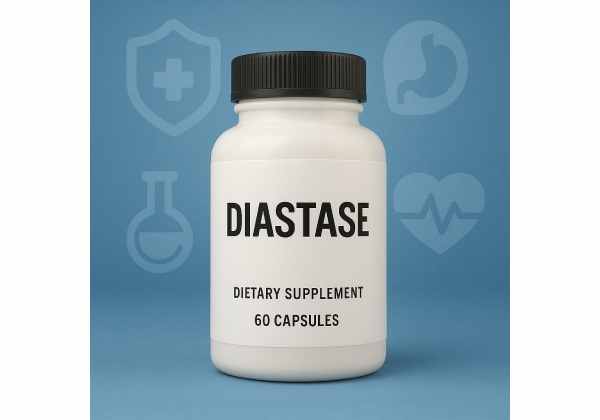
Diastase is the traditional name for alpha-amylase, the starch-digesting enzyme found in malted barley, fungi such as Aspergillus oryzae, and the human digestive tract. As a supplement, diastase helps break complex starches into smaller sugars so they can be absorbed more easily. People reach for it to address heavy, starchy meals, post-meal fullness, or functional dyspepsia–type symptoms. Unlike proteases or lactase, diastase does not digest proteins, fats, or lactose, and it does not replace prescription pancreatic enzymes in medical conditions like exocrine pancreatic insufficiency. When used correctly—timed with meals and at activity-based doses—it can be a targeted, practical tool for carbohydrate digestion, with a generally favorable safety profile and clear activity units on labels.
Top Diastase Highlights
- May reduce post-meal fullness with starchy foods; early evidence suggests multi-enzyme blends can improve dyspepsia symptoms.
- Works by cutting 1,4-alpha-glucosidic bonds in starch, aiding carbohydrate breakdown; it does not digest gluten or lactose.
- Typical serving provides activity labeled in FCC DU; stay within ≤34,000 DU per dose and ≤150,000 DU per day.
- Safety caveat: risk of allergy is low but possible, especially if you are sensitive to molds or enzymes.
- Avoid or seek medical guidance if pregnant or breastfeeding, or if you have diabetes or a history of enzyme allergies.
Table of Contents
- What is diastase and how it works
- Proven benefits and what to expect
- How to use diastase correctly
- How much diastase per day
- Side effects, safety, and who should avoid
- Research summary and where diastase fits
What is diastase and how it works
Diastase is a collective, historical term for alpha-amylase—the enzyme that begins the digestion of starch. In chemistry terms, alpha-amylase catalyzes the endo-hydrolysis of 1,4-alpha-D-glucosidic bonds in long chains of glucose, converting starch into smaller dextrins and maltose. In people, salivary and pancreatic amylases start this process; supplemental diastase simply adds more activity when a meal is rich in starches (bread, rice, potatoes, pasta, cereals).
You will see diastase sold under several names: alpha-amylase, fungal diastase, taka-diastase (a classic Aspergillus-derived form), or a malt extract standardized for amylase. The ingredient can be sourced from malted barley or produced by controlled fermentation of safe, non-pathogenic microbes such as Aspergillus oryzae or Aspergillus niger, then purified and standardized to a defined enzyme activity.
Because enzymes act on specific bonds, diastase has a narrow job description: it breaks starch. It does not:
- split peptide bonds (proteins; that is the job of proteases),
- cleave triglycerides (fats; lipases),
- or digest milk sugar (lactose; lactase).
It also does not degrade gluten, which is a protein, not a carbohydrate. If your symptoms are triggered by dairy sugar or proteins (like beans or gluten), diastase won’t address the root cause unless it is paired with the relevant enzymes (lactase, alpha-galactosidase, proteases).
Supplement labels typically list activity units instead of milligrams because the strength of enzymes depends on how active they are, not just how much they weigh. For diastase, modern labels should use FCC DU (Food Chemicals Codex Dextrinizing Units); you may also see DU = SKB, reflecting older terminology. Activity tells you how much starch the capsule can actually digest under defined conditions. This is why two products with the same milligrams can work quite differently—activity, not weight, drives results.
Finally, diastase is a protein and, like all proteins, it can lose activity with excessive heat or prolonged storage in poor conditions. That is why many manufacturers advise taking it with the first bites of a meal rather than sprinkling onto hot foods, and why enteric-coated forms exist for specific uses. Timing and formulation matter for real-world results.
Proven benefits and what to expect
The most relevant question is practical: will diastase make a difference at the table? For individuals whose discomfort centers on starch-heavy meals, diastase can help the gut handle that carbohydrate load by breaking starch into smaller sugars earlier and more efficiently. Users most often report improvements in post-meal fullness, upper-abdominal pressure, and a less “heavy” feeling after eating pizzas, pastas, rice dishes, or thickened soups.
What does the evidence say? Clinical research in this area has primarily studied multi-enzyme blends that include diastase along with proteases, lipases, and sometimes lactase and cellulases. In people with functional dyspepsia (a common upper-GI discomfort without structural disease), randomized controlled trials have shown symptom reductions versus placebo over several weeks. Improvements have been observed in validated dyspepsia scales and sleep quality, suggesting patients felt more comfortable overall, not just at a single meal. While such trials don’t isolate diastase alone, they do reflect real-world use: most consumers take diastase as part of a broad-spectrum digestive enzyme.
Expectations should remain measured:
- If your main trigger is starch quantity, diastase is a logical, targeted choice.
- If your symptoms track with dairy, legumes, or high-fat meals, add the matching enzyme(s) (lactase, alpha-galactosidase, lipase) or choose a blend that covers these.
- If you have a diagnosed digestive disease (e.g., exocrine pancreatic insufficiency, celiac disease, inflammatory bowel disease), talk with a clinician. Over-the-counter diastase is not a substitute for prescribed therapy (such as pancreatic enzyme replacement), and it does not allow safe gluten exposure in celiac disease.
Consumers also ask about glycemic effects. By converting starch into simpler sugars earlier in the digestive process, diastase may hasten carbohydrate availability. For most healthy individuals eating a balanced meal, this difference is small. If you have diabetes or use carbohydrate-modulating medications, it’s reasonable to monitor your post-meal glucose when you first try a product and discuss any consistent changes with your healthcare professional.
Finally, remember that enzymatic support works best as part of a broader approach: eat at a comfortable pace, chew thoroughly, and consider portion size and macronutrient balance. The combination of mindful meal structure plus targeted enzymes usually outperforms enzymes alone.
How to use diastase correctly
When to take it. For most people, the sweet spot is right before or with the first bites of a meal. That timing places diastase in the same “mixing bowl” as your food so it can begin acting while gastric contents are still being churned and before they move into the small intestine. If you forget, taking it during the meal is still reasonable; taking it long after eating is less likely to help, because the starches are already moving along or partially digested.
How often. Use diastase with starchy meals or snacks. You don’t need it with low-carb meals, and you can skip it with fruit-only snacks—amylases act on starch, not simple sugars like fructose.
Standalone versus blends. A single-ingredient diastase is fine if starch is your only issue. Otherwise, many people do better with broad-spectrum blends that also include lipase (for fats), proteases (for proteins), lactase (for dairy sugar), and alpha-galactosidase (for legumes/cruciferous vegetables). Match the enzyme to the trigger.
Form and handling.
- Capsules or tablets are the norm. Some are enteric-coated to protect activity until the small intestine; swallow these whole (do not crush or chew).
- Powders are convenient for people who dislike pills; avoid mixing into hot foods or beverages that can denature enzymes.
- Storage matters: Keep the product dry, sealed, and away from heat. Enzymes can lose activity with time, humidity, and excess warmth.
What to feel—and when. If diastase is going to help, you often notice a difference in 1–3 meals that would normally cause heaviness or fullness. For chronic upper-GI discomfort consistent with functional dyspepsia, clinical trials of enzyme blends have used daily supplementation over 4–8 weeks, with benefits accumulating over time. Track your response with the same meals to keep expectations realistic.
What not to expect.
- Diastase does not treat reflux driven by LES mechanics, gastric ulcers, or gallbladder disease. If you have red-flag symptoms (unintentional weight loss, persistent vomiting, bleeding/black stools, severe pain, progressive dysphagia), seek medical care promptly.
- It is not a weight-loss agent.
- It does not make it “safe” to eat gluten if you have celiac disease.
Practical pairing. If a pasta dinner leaves you heavy and a bowl of ice cream leaves you gassy, consider a dual-strategy: a blend that supplies diastase plus lactase. If beans are your nemesis, add alpha-galactosidase. Keep it simple and targeted.
How much diastase per day
Enzymes should be dosed by activity, not weight. For diastase, the modern standard is FCC DU (Dextrinizing Units). Labels may also state milligrams, but milligrams tell you only how much powder is present—not how active it is. Always look for FCC DU on the facts panel.
Regulatory upper limits. One authoritative, activity-based framework sets clear ceilings for adult oral use of alpha-amylase (diastase):
- Do not exceed 34,000 FCC DU per single dose.
- Do not exceed 150,000 FCC DU in one day.
These ceilings are generous and designed to encompass most real-world products. They also reflect the way enzyme potency is measured in the lab—by how quickly the enzyme dextrinizes starch under standardized conditions.
Where to start. If you are new to diastase, begin at the lower end of a product’s suggested use (for example, one capsule with a starchy meal). See how you feel with a typical trigger meal (pizza, pasta, rice bowl). If there is no noticeable difference after two or three similar meals, you can step up to the next labeled serving, staying within the per-dose and daily ceilings above.
A quick label-reading guide.
- Find “alpha-amylase” or “diastase” on the ingredient list. Confirm the source (e.g., Aspergillus oryzae, malted barley).
- Locate the activity: it should read something like “Alpha-amylase 10,000 FCC DU” per capsule (or per scoop).
- Match to your meal: bigger, starch-heavy meals may justify higher activity; smaller meals need less.
- Mind totals: count how many doses you take in a day and ensure your daily total stays under 150,000 DU.
Units you may see.
- FCC DU is the current standard.
- SKB is an older unit historically used for amylase; many labels note DU = SKB.
- Some brands list FAU/BAU for other enzymes (not amylase). Focus on DU for diastase.
Special cases.
- Enteric-coated tablets: follow the product’s per-dose instructions; do not split or chew (coating ensures activity release downstream).
- Blends: the per-serving DU for diastase still counts toward your dose ceilings; add up all forms taken that day.
- Children: most adult-focused diastase labels are not calibrated for pediatric dosing; discuss with a clinician before using in children.
If you are also taking carbohydrate-active medications (for example, alpha-glucosidase inhibitors), discuss diastase with your prescriber and monitor glucose when you start. While robust interaction data are limited, real-world monitoring is prudent.
Side effects, safety, and who should avoid
For most healthy adults, diastase has a strong safety margin when used as directed and within activity-based limits. High-quality safety assessments of alpha-amylase used in foods and processing consistently find no systemic toxicity at exposure levels orders of magnitude above typical intake. Still, several practical cautions apply:
Common experiences.
- Most people notice no side effects.
- A minority may experience mild GI changes—looser stools or transient gas—when first adding enzyme blends. These effects usually resolve with dose adjustment or taking the product with, not after, meals.
Allergy and sensitivity.
- Alpha-amylase (especially from microbial sources) is a known occupational allergen in bakers and enzyme-industry workers when inhaled as dust. As an oral supplement, the likelihood of an allergic reaction is low, but it is not zero. If you have a history of mold or enzyme allergies, exercise caution. Stop use if rash, itching, wheeze, or swelling appears and seek medical care.
- People with celiac disease sometimes ask whether diastase contains gluten. The enzyme itself does not; however, always check the label for allergens and manufacturing disclosures. Products should clearly state if any gluten-containing excipients are present.
Special populations.
- Pregnancy or breastfeeding: lack of robust data means a precautionary approach—consult a qualified clinician before use.
- Diabetes: because diastase accelerates starch breakdown, it may modestly affect post-prandial glycemia. If you try diastase, monitor your post-meal glucose initially and coordinate with your healthcare team.
- Children: use only with clinician guidance, as adult products are not dosed for pediatric needs.
- Chronic GI disease: if you have pancreatic insufficiency, inflammatory bowel disease, peptic ulcer disease, or unexplained weight loss, speak with a healthcare professional. Diastase does not replace prescription pancreatic enzymes or disease-specific treatments.
Interactions and timing.
- No strong, well-documented drug–diastase interactions are established, but because diastase alters the digestion of starch, common-sense glucose monitoring is wise when you start if you use diabetes medications.
- Take diastase with meals. Taking it on an empty stomach is less useful for digestion and more likely to cause minor GI sensations in sensitive individuals.
Product quality.
- Choose brands that declare enzyme activity (FCC DU) per serving and list source organisms.
- Look for third-party testing or compliance with compendial methods (Food Chemicals Codex).
- Store capsules dry and cool, and mind expiration dates; enzyme activity drifts downward over time with poor storage.
If any symptom worsens or you develop red-flag signs—persistent vomiting, GI bleeding, fever, severe pain—stop and seek prompt medical evaluation.
Research summary and where diastase fits
Mechanism is clear: diastase (alpha-amylase) cleaves internal 1,4-alpha linkages in starch, yielding smaller carbohydrates that are easier to absorb. This action is specific; it does not digest proteins, lipids, or lactose. The specificity explains why targeted pairing with other enzymes often produces better symptom relief than diastase alone when meals are mixed.
Clinical outcomes center on functional dyspepsia and post-prandial comfort. Modern randomized, double-blind, placebo-controlled trials of multi-enzyme blends derived from fungal fermentation (which include diastase) show statistically significant improvements in validated symptom scales (quality of life, pain scores, sleep quality) over 1–2 months of daily use. Safety in these trials has been good, with adverse events similar to placebo. Other randomized and open-label studies in related upper-GI symptom clusters have reported reduced bloating and fullness and good tolerability, though sample sizes vary and formulations differ across studies.
What is still uncertain?
- Is diastase the key driver of benefit in a blend, or do proteases, lipases, or other carbohydrate enzymes do most of the work? We lack head-to-head “diastase-only vs full blend” trials using standardized outcomes.
- Population targeting: Who benefits most? Likely candidates include people whose symptoms track with starch load—large portions of potatoes, rice, breads, and pasta—and those with functional dyspepsia patterns dominated by post-prandial fullness rather than burning pain.
- Metabolic effects: For most healthy eaters, any glycemic impact is minor, but this has not been tested rigorously across diverse dietary patterns and diabetes therapies.
Safety landscape is favorable. High-quality risk assessments of alpha-amylase used in food processing show wide margins of exposure and no genotoxic or systemic toxicity at relevant intakes. A low-probability allergy risk remains, mainly extrapolated from occupational sensitization data; in oral use, reactions are uncommon and typically mild when they occur. Sensible precautions apply in pregnancy, breastfeeding, and diabetes.
Practical takeaway. If your discomfort reliably follows starch-heavy meals, a well-made diastase product—or a balanced multi-enzyme blend that includes diastase—taken with the first bites is a rational, low-risk trial. Read the label for FCC DU activity, calculate your per-dose and daily totals, and give it several meals or a few weeks (if you have chronic upper-GI symptoms) to judge effect. Pair it with straightforward meal hygiene—pace, portion, chewing—and you’ll have a clear signal as to whether it belongs in your routine.
References
- NATURAL HEALTH PRODUCT ALPHA-AMYLASE (2025) (Guideline)
- Safety evaluation of the food enzyme α‐amylase from the non‐genetically modified Aspergillus sp. strain FUA | EFSA (2025) (Guideline)
- Efficacy of digestive enzyme supplementation in functional dyspepsia: A monocentric, randomized, double-blind, placebo-controlled, clinical trial – PubMed (2023) (RCT)
- Evaluation of the Safety and Efficacy of a Multienzyme Complex in Patients with Functional Dyspepsia: A Randomized, Double-Blind, Placebo-Controlled Study – PMC (2018) (RCT)
Disclaimer
This article is for educational purposes and does not provide medical advice. It is not a substitute for professional diagnosis, treatment, or individualized nutrition guidance. Always consult a qualified healthcare professional before starting any new supplement, especially if you are pregnant or breastfeeding, have diabetes or chronic gastrointestinal disease, take prescription medications, or have known allergies to enzymes or molds.
If you found this guide helpful, please consider sharing it with a friend or on Facebook, X (formerly Twitter), or your preferred platform. Your support helps us continue creating clear, trustworthy health content. Thank you.

